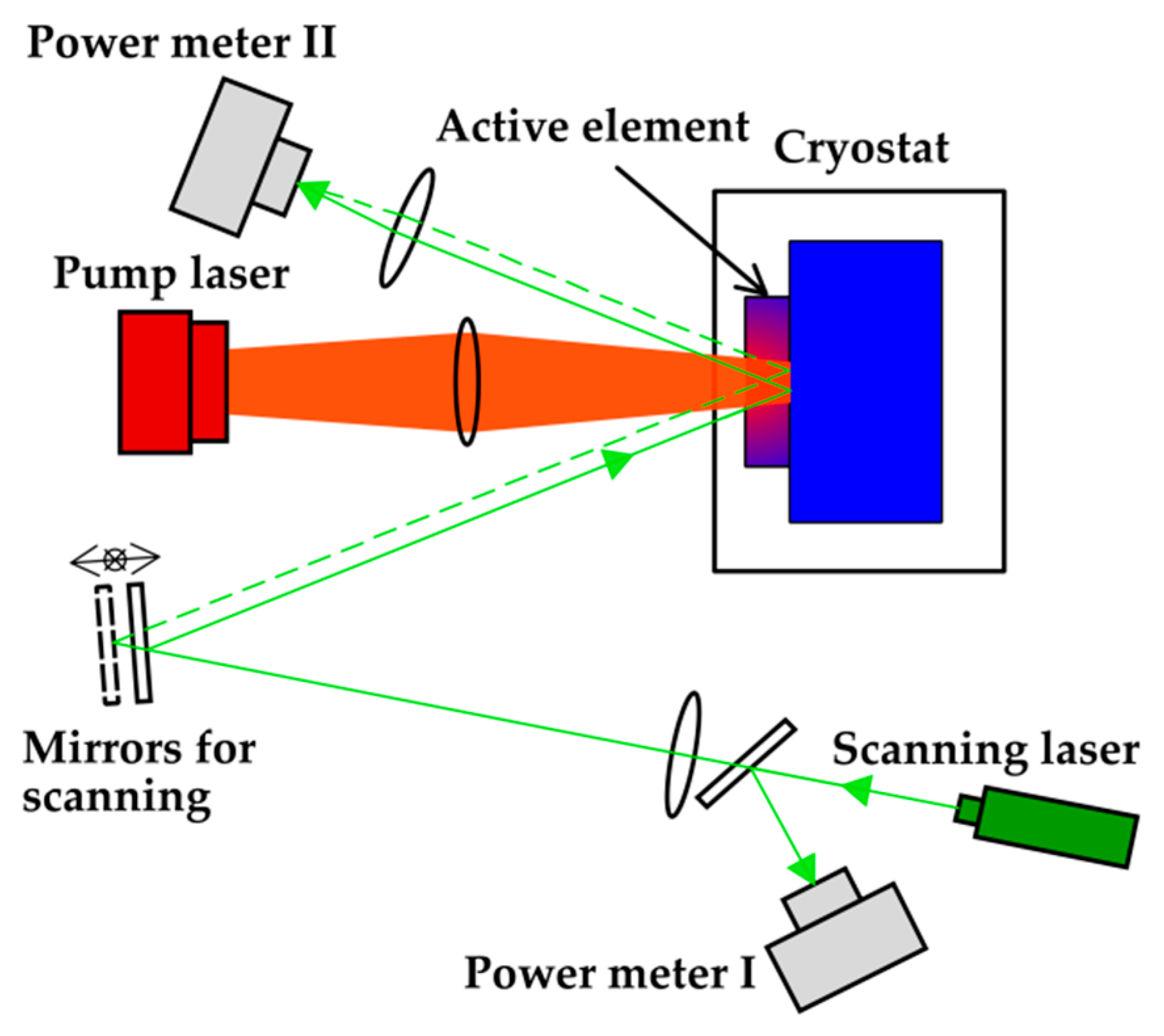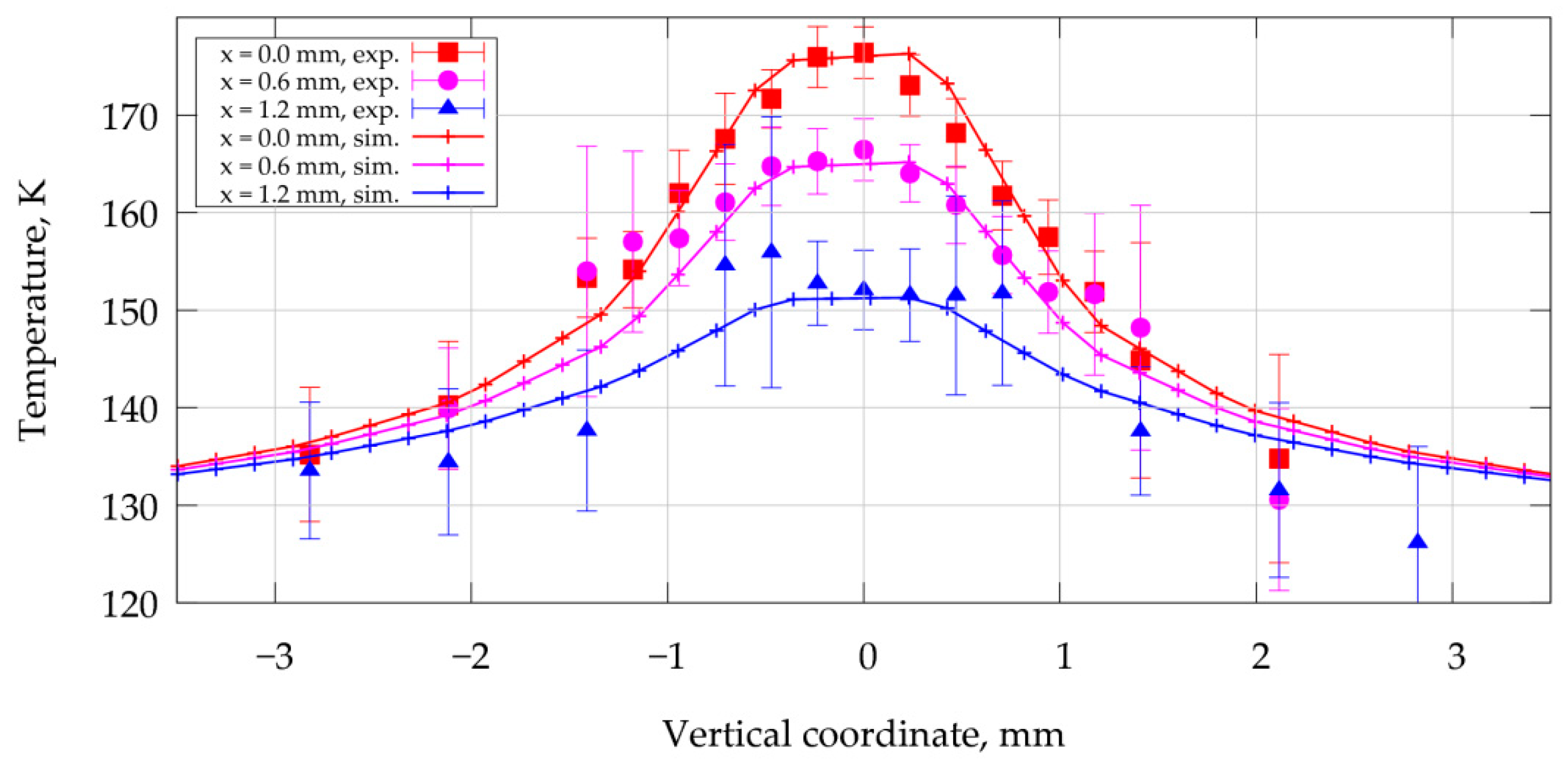Laser Method for Studying Temperature Distribution within Yb:YAG Active Elements
Abstract
:1. Introduction
2. Laser Thermometry Method
3. Results
4. Conclusions
Author Contributions
Funding
Institutional Review Board Statement
Informed Consent Statement
Data Availability Statement
Conflicts of Interest
References
- Wang, Y.; Chi, H.; Baumgarten, C.; Dehne, K.; Meadows, A.R.; Davenport, A.; Murray, G.; Reagan, B.A.; Menoni, C.S.; Rocca, J.J. 1.1 J Yb:YAG picosecond laser at 1 kHz repetition rate. Opt. Lett. 2020, 45, 6615–6618. [Google Scholar] [CrossRef]
- Herkommer, C.; Krötz, P.; Jung, R.; Klingebiel, S.; Wandt, C.; Bessing, R.; Walch, P.; Produit, T.; Michel, K.; Bauer, D.; et al. Ultrafast thin-disk multipass amplifier with 720 mJ operating at kilohertz repetition rate for applications in atmospheric research. Opt. Express 2020, 28, 30164–30173. [Google Scholar] [CrossRef]
- Nubbemeyer, T.; Kaumanns, M.; Ueffing, M.; Gorjan, M.; Alismail, A.; Fattahi, H.; Brons, J.; Pronin, O.; Barros, H.G.; Major, Z.; et al. 1 kW, 200 mJ picosecond thin-disk laser system. Opt. Lett. 2017, 42, 1381–1384. [Google Scholar] [CrossRef]
- Ogino, J.; Tokita, S.; Kitajima, S.; Yoshida, H.; Li, Z.; Motokoshi, S.; Morio, N.; Tsubakimoto, K.; Fujioka, K.; Kodama, R.; et al. 10-J, 100-Hz conduction-cooled active-mirror laser. Opt. Contin. 2022, 1, 1270–1277. [Google Scholar] [CrossRef]
- Chvykov, V.; Chi, H.; Wang, Y.; Dehne, K.; Berrill, M.; Rocca, J.J. Demonstration of a side-pumped cross-seeded thin-slab pre-amplifier for high-power Ti:Sa laser systems. Opt. Lett. 2022, 47, 3463–3466. [Google Scholar] [CrossRef]
- Kretschmar, M.; Tuemmler, J.; Schütte, B.; Hoffmann, A.; Senfftleben, B.; Mero, M.; Sauppe, M.; Rupp, D.; Vrakking, M.J.J.; Will, I.; et al. Thin-disk laser-pumped OPCPA system delivering 4.4 TW few-cycle pulses. Opt. Express 2020, 28, 34574–34585. [Google Scholar] [CrossRef]
- Hubka, Z.; Antipenkov, R.; Boge, R.; Erdman, E.; Greco, M.; Green, J.T.; Horacek, M.; Majer, K.; Mazanec, T.; Mazurek, P.; et al. 120 mJ, 1 kHz, picosecond laser at 515 nm. Opt. Lett. 2021, 46, 5655–5658. [Google Scholar] [CrossRef]
- Fan, G.; Legare, K.; Cardin, V.; Xie, X.; Safaei, R.; Kaksis, E.; Andriukaitis, G.; Pugzlys, A.; Schmidt, B.E.; Wolf, J.P.; et al. Ultrafast magnetic scattering on ferrimagnets enabled by a bright Yb-based soft x-ray source. Optica 2022, 9, 399–407. [Google Scholar] [CrossRef]
- Boltaev, G.S.; Kim, V.V.; Iqbal, M.; Abbasi, N.A.; Yalishev, V.S.; Ganeev, R.A.; Alnaser, A.S. Application of 150 kHz Laser for High-Order Harmonic Generation in Different Plasmas. Photonics 2020, 7, 66. [Google Scholar] [CrossRef]
- Koliyadu, J.C.P.; Künzel, S.; Wodzinski, T.; Keitel, B.; Duarte, J.; Williams, G.O.; João, C.P.; Pires, H.; Hariton, V.; Galletti, M.; et al. Optimization and Characterization of High-Harmonic Generation for Probing Solid Density Plasmas. Photonics 2017, 4, 25. [Google Scholar] [CrossRef]
- Produit, T.; Walch, P.; Herkommer, C.; Mostajabi, A.; Moret, M.; Andral, U.; Sunjerga, A.; Azadifar, M.; André, Y.B.; Mahieu, B.; et al. The laser lightning rod project. Eur. Phys. J. Appl. Phys. 2021, 93, 10504. [Google Scholar] [CrossRef]
- Higginson, A.; Wang, Y.; Chi, H.; Goffin, A.; Larkin, I.; Milchberg, H.M.; Rocca, J.J. Wake dynamics of air filaments generated by high-energy picosecond laser pulses at 1 kHz repetition rate. Opt. Lett. 2021, 46, 5449–5452. [Google Scholar] [CrossRef]
- Mason, P.D.; Fitton, M.; Lintern, A.; Banerjee, S.; Ertel, K.; Davenne, T.; Hill, J.; Blake, S.P.; Phillips, P.J.; Butcher, T.J.; et al. Scalable design for a high energy cryogenic gas cooled diode pumped laser amplifier. Appl. Opt. 2015, 54, 4227–4238. [Google Scholar] [CrossRef]
- Petrov, V.A.; Petrov, V.V.; Kuptsov, G.V.; Laptev, A.V.; Galutskiy, V.V.; Stroganova, E.V. YAG:Yb crystal with non-linear doping ions distribution as promising active element for high average power laser systems. Laser Phys. 2021, 31, 035003. [Google Scholar] [CrossRef]
- Azrakantsyan, M.; Albach, D.; Ananyan, N.; Gevorgyan, V.; Chanteloup, J.-C. Yb3+:YAG crystal growth with controlled doping distribution. Opt. Mater. Express 2012, 2, 20–30. [Google Scholar] [CrossRef]
- Chénais, S.; Forget, S.; Druon, F.; Balembois, F.; Georges, P. Direct and absolute temperature mapping and heat transfer measurements in diode-end-pumped Yb:YAG. Appl. Phys. 2004, 79, 221–224. [Google Scholar] [CrossRef] [Green Version]
- Tamer, I.; Keppler, S.; Körner, J.; Hornung, M.; Hellwing, M.; Schorcht, F.; Hein, J.; Kaluza, M. Modeling of the 3D spatio-temporal thermal profile of joule-class Yb3+-based laser amplifiers. High Power Laser Sci. Eng. 2019, 7, e42. [Google Scholar] [CrossRef] [Green Version]
- Boudeile, J.; Didierjean, J.; Camy, P.; Doualan, J.L.; Benayad, A.; Ménard, V.; Moncorgé, R.; Druon, F.; Balembois, F.; Georges, P. Thermal behaviour of ytterbium-doped fluorite crystals under high power pumping. Opt. Express 2008, 16, 10098–10109. [Google Scholar] [CrossRef] [Green Version]
- Didierjean, J.; Herault, E.; Balembois, F.; Georges, P. Thermal conductivity measurements of laser crystals by infrared thermography. Application to Nd:doped crystals. Opt. Express 2008, 16, 8995–9010. [Google Scholar] [CrossRef] [Green Version]
- Petit, J.; Viana, B.; Goldner, P. Internal temperature measurement of an ytterbium doped material under laser operation. Opt. Express 2011, 19, 1138–1146. [Google Scholar] [CrossRef]
- Xu, C.; Huang, Y.; Lin, Y.; Huang, J.; Gong, X.; Luo, Z.; Chen, Y. Real-time measurement of temperature distribution inside a gain medium of a diode-pumped Er3+/Yb3+ 1.55 μm laser. Opt. Lett. 2017, 42, 3383–3386. [Google Scholar] [CrossRef]
- Furuse, H.; Kawanaka, J.; Miyanaga, N.; Chosrowjan, H.; Fujita, M.; Takeshita, K.; Izawa, Y. Output characteristics of high power cryogenic Yb:YAG TRAM laser oscillator. Opt. Express 2012, 20, 21739–21748. [Google Scholar] [CrossRef]
- Chi, H.; Dehne, K.A.; Baumgarten, C.M.; Wang, H.; Yin, L.; Reagan, B.A.; Rocca, J.J. In situ 3-D temperature mapping of high average power cryogenic laser amplifiers. Opt. Express 2018, 26, 5240–5252. [Google Scholar] [CrossRef]
- Demirbas, U.; Thesinga, J.; Kellert, M.; Reuter, S.; Kärtner, F.X.; Pergament, M. Error analysis of contactless optical temperature probing methods for cryogenic Yb:YAG. Appl. Phys. 2021, 127, 112. [Google Scholar] [CrossRef]
- Demirbas, U.; Thesinga, J.; Kellert, M.; Kärtner, F.X.; Pergament, M. Comparison of different in situ optical temperature probing techniques for cryogenic Yb:YLF. Opt. Mater. Express 2020, 10, 3403–3413. [Google Scholar] [CrossRef]
- Körner, J.; Yue, F.; Hein, J.; Kaluza, M.C. Spatially and temporally resolved temperature measurement in laser media. Opt. Lett. 2016, 41, 2525–2528. [Google Scholar] [CrossRef]
- Kuptsov, G.V.; Petrov, V.A.; Petrov, V.V.; Laptev, A.V.; Konovalova, A.O.; Kirpichnikov, A.V.; Pestryakov, E.V. Laser amplification in an Yb:YAG active mirror with a significant temperature gradient. Quantum Electron. 2021, 51, 679–682. [Google Scholar] [CrossRef]
- Petrov, V.V.; Kuptsov, G.V.; Nozdrina, A.I.; Petrov, V.A.; Laptev, A.V.; Kirpichnikov, A.V.; Pestryakov, E.V. Contactless method for studying temperature within the active element of a multidisk cryogenic amplifier. Quantum Electron. 2019, 49, 358–361. [Google Scholar] [CrossRef]
- Petrov, V.V.; Petrov, V.A.; Kuptsov, G.V.; Laptev, A.V.; Kirpichnikov, A.V.; Pestryakov, E.V. Modelling of the laser amplification process with allowance for the effect of the temperature distribution in an Yb:YAG gain element on the thermophysical and lasing characteristics of the medium. Quantum Electron. 2020, 50, 315–320. [Google Scholar] [CrossRef]
- Körner, J.; Krüger, M.; Reiter, J.; Münzer, A.; Hein, J.; Kaluza, M.C. Temperature dependent spectroscopic study of Yb3+-doped KG(WO4)2, KY(WO4)2, YAlO3 and YLiF4 for laser applications. Opt. Mater. Express 2020, 10, 2425–2438. [Google Scholar] [CrossRef]
- Püschel, S.; Kalusniak, S.; Kränkel, C.; Tanaka, H. Temperature-dependent radiative lifetime of Yb:YLF: Refined cross sections and potential for laser cooling. Opt. Express 2021, 29, 11106–11120. [Google Scholar] [CrossRef] [PubMed]
- Demirbas, U.; Thesinga, J.; Kellert, M.; Kärtner, F.X.; Pergament, M. Detailed investigation of absorption, emission and gain in Yb:YLF in the 78–300 K range. Opt. Mater. Express 2021, 11, 250–272. [Google Scholar] [CrossRef]
- Körner, J.; Jambunathan, V.; Hein, J.; Seifert, R.; Loeser, M.; Siebold, M.; Schramm, U.; Sikocinski, P.; Lucianetti, A.; Mocek, T.; et al. Spectroscopic characterization of Yb3+-doped laser materials at cryogenic temperatures. Appl. Phys. 2014, 116, 75–81. [Google Scholar] [CrossRef]
- Banerjee, S.; Koerner, J.; Siebold, M.; Yang, Q.; Ertel, K.; Mason, P.D.; Phillips, J.; Loeser, M.; Zhang, H.; Lu, S.; et al. Temperature dependent emission and absorption cross section of Yb3+ doped yttrium lanthanum oxide (YLO) ceramic and its application in diode pumped amplifier. Opt. Express 2013, 21, A726–A734. [Google Scholar] [CrossRef]
- Šulc, J.; Němec, M.; Jelínková, H.; Nejezchleb, K.; Škoda, V. Temperature influence on microchip lasers based on Nd:YAG crystal. Proc. SPIE 2019, 10896, 303–312. [Google Scholar] [CrossRef]






Publisher’s Note: MDPI stays neutral with regard to jurisdictional claims in published maps and institutional affiliations. |
© 2022 by the authors. Licensee MDPI, Basel, Switzerland. This article is an open access article distributed under the terms and conditions of the Creative Commons Attribution (CC BY) license (https://creativecommons.org/licenses/by/4.0/).
Share and Cite
Kuptsov, G.V.; Konovalova, A.O.; Petrov, V.A.; Laptev, A.V.; Atuchin, V.V.; Petrov, V.V. Laser Method for Studying Temperature Distribution within Yb:YAG Active Elements. Photonics 2022, 9, 805. https://doi.org/10.3390/photonics9110805
Kuptsov GV, Konovalova AO, Petrov VA, Laptev AV, Atuchin VV, Petrov VV. Laser Method for Studying Temperature Distribution within Yb:YAG Active Elements. Photonics. 2022; 9(11):805. https://doi.org/10.3390/photonics9110805
Chicago/Turabian StyleKuptsov, Gleb V., Alyona O. Konovalova, Vladimir A. Petrov, Alexey V. Laptev, Victor V. Atuchin, and Victor V. Petrov. 2022. "Laser Method for Studying Temperature Distribution within Yb:YAG Active Elements" Photonics 9, no. 11: 805. https://doi.org/10.3390/photonics9110805
APA StyleKuptsov, G. V., Konovalova, A. O., Petrov, V. A., Laptev, A. V., Atuchin, V. V., & Petrov, V. V. (2022). Laser Method for Studying Temperature Distribution within Yb:YAG Active Elements. Photonics, 9(11), 805. https://doi.org/10.3390/photonics9110805




